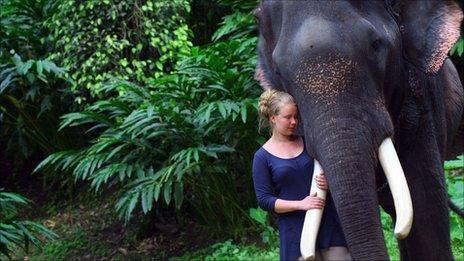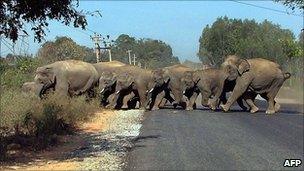'How an elephant changed my life'
- Published

Usually only men are trained to take the job of a mahout
A young Finnish woman is intent on pursuing a career as an elephant rider - or mahout - after spending time working with the animals in India.
Laura Puukko, 25, says that in December she will complete her homeopathy studies in Finland before embarking on her new career.
Her unusual career choice was made after a life-changing trip to the southern Indian state of Kerala last year.
"When I first saw an elephant in Kumli in Kerala, I fell in love with it," she says.
"I just asked whether I could stay there. Those words just came out of my mouth. I was not thinking. When they said 'Yes', I decided to stay."
'Very ambitious'
Laura says she first started by walking alongside elephants and then helped others who fed them. Gradually she started to train as a mahout.
Usually, a mahout starts as a boy when he is assigned an elephant early in its life. They are attached to each other throughout the elephant's life.
"Soon I became very ambitious. I spent three months here. I came early in the morning and left late in the evening. So it is full-time elephants for me. I learned the routine."

Ms Puukko hopes that her training in homeopathy will help her in her work with elephants
Like other mahouts, she says, she takes the elephants to the river to give them a bath and helps out with other tasks necessary for their upkeep.
She made another trip to India this summer. Now, she is getting trained by Elephant Junction - a private firm which provides elephant safaris.
Elephants have played a major part in Indian history and culture. Until the introduction of artillery in the first battle of Panipat (1526) they were used in large numbers on the battlefield.
A large section of Hindus venerate them. They continue to play an important role in Hindu temple rituals of south India.
Kerala has a long history of domesticating elephants. Even now it has a number of working elephants owned by private individuals.
Elephants were once used in large numbers to transport wood from the forest. But legislation banning logging in the forests has made many of them redundant.
Yet many elephants are still used for pleasure trips - similar to the ones used at the centre where Laura is getting trained.
Language barrier
"Last year I trained with Ganga. But since she is pregnant I am now getting trained with Meera. She is an unbelievably intelligent animal. Next time when I come here I will get trained with a male elephant," Laura says.
Among Asian elephants, only the males have tusks and are far more difficult to handle than females.
But Laura's immediate progress is hampered because of the language barrier. All the other mahouts working there speak only Malayalam, making it imperative for her to learn the language.
"I don't fully understand Malayalam," Laura acknowledges.
But she has picked up a few words used to command elephants.

India is home to thousands of wild and domesticated elephants
"Learning Malayalam is tougher than handling elephants. Elephants communicate with you. It usually tells you very much. But if you don't know Malayalam you can't do anything."
An Elephant Junction official says that Laura has shown remarkable interest and enthusiasm.
"Like any other person she is taught some basic facts about elephants like what they will eat, how much they will drink, how many teeth they have and so on," says Shaji Nair who works as a manager there.
Trainees are also told about elephant behaviour and the signs to watch out for in order to gauge their mood.
Usually men are trained to take up the job of mahout. Mr Nair says that Laura is being given the same kind of training a male candidate receives.
"We use verbal commands and touch commands to guide the elephants. These commands are given using an instrument called an ankusa," he said.
These are sharp metal hooks used to tap the elephant on the head and other sensitive areas - like the mouth and inner ear - to give it directions.
"For a mahout, learning the local language is a must because all the elephants in a particular area are used to the regional dialect," Mr Nair adds.
He says that it is impossible to put a time-frame on how long it will take for Laura or anyone to become a mahout.
Trampled to death
"My teacher says I have now crossed 50%. The rest of it will come only by practice. But that will also depend on the rapport I build with elephants," says Laura.
The relationship between mahout and elephant often lasts for decades. Laura says she first tries to develop a bond with an elephant before giving commands.
But the job of the mahout has its own risks. It is not uncommon for them to be trampled to death by their own elephants. Some elephants have run amok during religious processions, causing death and panic.
"It is said you have to trust your elephants. One has to respect the animal. There is always an element of risk and fear. But if something goes wrong you don't have a chance," Laura says.
She has already experienced a few tense moments.
"When I started to give commands and expected them to obey, they tested me," she says.
This job may look attractive to Laura but it is poorly paid. A mahout may earn about $10 on a good day. But Laura says money does not matter.
"If you do something that your heart really tells you to do, I don't think money is the issue," she says.
She hopes her university education will support her in her new-found love.
"Here in India all the elephants are treated in the ayruvedic and homeopathic way. I hope this will also help me to secure a future with elephants here.
- Published8 June 2011
- Published3 November 2010
- Published4 August 2010
- Published23 September 2010